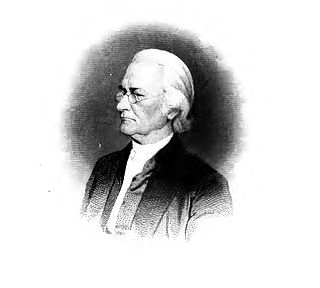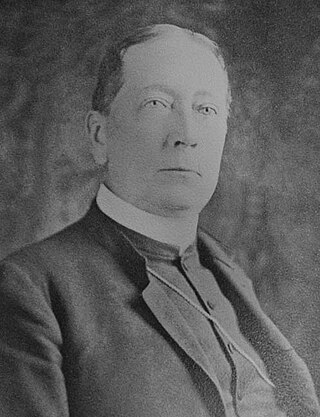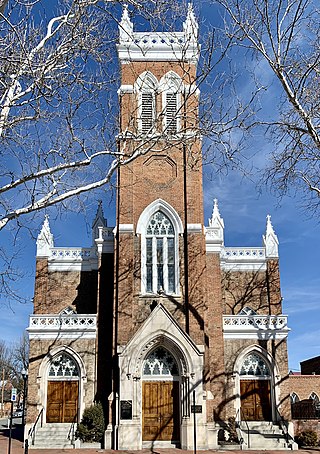
Charles Wesley was an English Anglican cleric and a principal leader of the Methodist movement. Wesley was a prolific hymnwriter who wrote over 6,500 hymns during his lifetime. His works include "And Can It Be", "O for a Thousand Tongues to Sing", "Christ the Lord Is Risen Today", "Love Divine, All Loves Excelling", the carol "Hark! The Herald Angels Sing", and "Lo! He Comes With Clouds Descending".

Truro Anglican Church is an Anglican church in Fairfax, Virginia, USA.

William Meade was an American Episcopal bishop, the third Bishop of Virginia.

The Episcopal Diocese of Georgia, USA is one of 20 dioceses that comprise Province IV of the US Episcopal Church, and is a diocese within the worldwide Anglican Communion. The current bishop is Frank S. Logue, who succeeded Scott Anson Benhase on May 30, 2020, when he was consecrated 11th bishop of Georgia at a service held in Christ Church in Savannah, Georgia.

The Episcopal Diocese of Bethlehem covers fourteen counties in Pennsylvania to the north and west of Philadelphia. The current bishop, the Rt. Rev. Kevin D. Nichols, was elected as Bishop on April 28, 2018, and consecrated on September 15, 2018. The cathedral is the Cathedral Church of the Nativity in Bethlehem. The pro-Cathedral is St. Stephen's Cathedral in Wilkes-Barre, Pennsylvania.

St. John's Church in Savannah is a parish of the Episcopal Diocese of Georgia.

Thomas John Claggett was the first bishop of the newly formed American Episcopal Church to be consecrated on American soil and the first bishop of the recently established (1780) Diocese of Maryland.

The Episcopal Diocese of Kentucky is a diocese of the Episcopal Church in the United States of America, encompassing the western half of the state of Kentucky.

St. Mary's Episcopal Cathedral, designed by Memphis architect Bayard Snowden Cairns, located near downtown Memphis, Tennessee, is the cathedral church of the Episcopal Diocese of West Tennessee and the former cathedral of the old statewide Episcopal Diocese of Tennessee.

Cleland Kinloch Nelson was the Third Bishop of the U.S. state of Georgia and the first bishop of the Episcopal Diocese of Atlanta. Nelson was the 160th bishop of the Episcopal Church in the United States of America (ECUSA).

Middleton Stuart Barnwell was the seventh Bishop of the Episcopal Diocese of Idaho and the fifth Bishop of the Episcopal Diocese of Georgia. Barnwell was the 349th bishop of the Episcopal Church in the United States of America. He was also the first president of what is now Boise State University.

The Christ Church Guilford, historically known as the "Old Brick Church," is an historic Episcopal church located about one mile from Guilford, now part of Columbia, in Howard County, Maryland. The small Georgian church was completed in 1809. It was constructed of handmade brick laid in English garden wall brick bond with unmarked joints.

George Paul Reeves was an American bishop. He was the Seventh Bishop of Georgia in the Episcopal Church in the United States of America (ECUSA).
Henry Irving Louttit, Jr. served as the ninth Bishop of Georgia. He was the 901st bishop of the Episcopal Church in the United States of America (ECUSA).

Immanuel Episcopal Church is a historic Episcopal church and cemetery located near Mechanicsville, Hanover County, Virginia.

Christ Church, or Christ Episcopal Church, is an Anglican church in Winchester, Frederick County, Virginia. The church was founded in 1738, with its first vestry elected in 1742. It is the seat of Frederick Parish, Diocese of Virginia, which once covered half of the Shenandoah Valley and western Virginia, including what became West Virginia. The current church building, the parish's third, was designed by Robert Mills - it was completed in 1828, and is the oldest church building continuously used for religious purposes in the county. It is a contributing building in the local Historic District which predates the National Register of Historic Places, and which has been expanded three times since 1980.

John Durham Wing was the second bishop of the Diocese of South Florida in The Episcopal Church, serving from 1932 to 1950. He was elected bishop coadjutor in 1925.

Christ Church is an Episcopal church in St. Simons, Georgia. Beginning as a mission in 1736, the parish would be one of the first to form the Episcopal Diocese of Georgia in 1823, along with Christ Church in Savannah, Georgia and Saint Paul's Church in Augusta, Georgia. The current building was built in 1884 and is adjacent to Fort Frederica National Monument.

Christ Church Anglican (CCA) is an Anglican parish in the Thomas Square neighborhood of Savannah, Georgia. It traces its history to 1733, when Christ Church was founded as the oldest Anglican presence in Georgia. In 2006, the majority of the clergy and parishioners of Christ Church departed from the Episcopal Diocese of Georgia; in 2012, after a loss in a court case, the congregation leaving the Episcopal Church relocated and renamed itself Christ Church Anglican. It is today part of the Gulf Atlantic Diocese in the Anglican Church in North America; its building is a contributing property to the Thomas Square Streetcar Historic District.
David C. Bryan is an American bishop of the Anglican Church in North America. Consecrated in 2013 to serve in PEARUSA, the Anglican Church of Rwanda's missionary district in North America, Bryan has since 2016 been bishop suffragan and area bishop for South Carolina in the Diocese of the Carolinas.





















